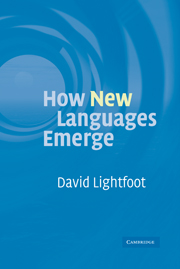Book contents
- Frontmatter
- Contents
- Preface
- 1 Internal languages and the outside world
- 2 Traditional language change
- 3 Some properties of language organs
- 4 Languages emerging in children
- 5 New E-language cuing new I-languages
- 6 The use and variation of grammars
- 7 The eruption of new grammars
- 8 A new historical linguistics
- References
- Index
5 - New E-language cuing new I-languages
Published online by Cambridge University Press: 02 February 2010
- Frontmatter
- Contents
- Preface
- 1 Internal languages and the outside world
- 2 Traditional language change
- 3 Some properties of language organs
- 4 Languages emerging in children
- 5 New E-language cuing new I-languages
- 6 The use and variation of grammars
- 7 The eruption of new grammars
- 8 A new historical linguistics
- References
- Index
Summary
Changes in I-languages
We saw in chapter 2 that our nineteenth-century predecessors developed linguistics as a distinct discipline and were concerned exclusively with language change. For them, languages were external objects and changed in systematic ways according to “laws” and general notions of directionality. Languages were related to each other to different degrees, modeled in tree diagrams (Stammbäume), and they changed at certain rates that could be discovered. Linguists of the time focused on the products of human behavior rather than on the internal processes that underlie the behavior, although other approaches were put forward towards the end of the century, particularly in the work of Hermann Paul and phoneticians like Eduard Sievers.
From our perspective, they focused on E-languages and sought to explain, for example, how one E-language, Latin, could develop into the new E-languages of French, Spanish, Italian, Sardinian, and the other Romance languages. Those idealizations were useful to a degree, they have been resilient over a long period, and those of us who deny that E-languages have any biological reality and deny that they can be defined in any precise way, nonetheless find it convenient to refer to English, Swedish, and other E-languages for certain purposes. Furthermore, we shall see that E-language, although not systematic, represents a kind of reality that is indispensable for our account of new I-languages.
- Type
- Chapter
- Information
- How New Languages Emerge , pp. 87 - 111Publisher: Cambridge University PressPrint publication year: 2006

